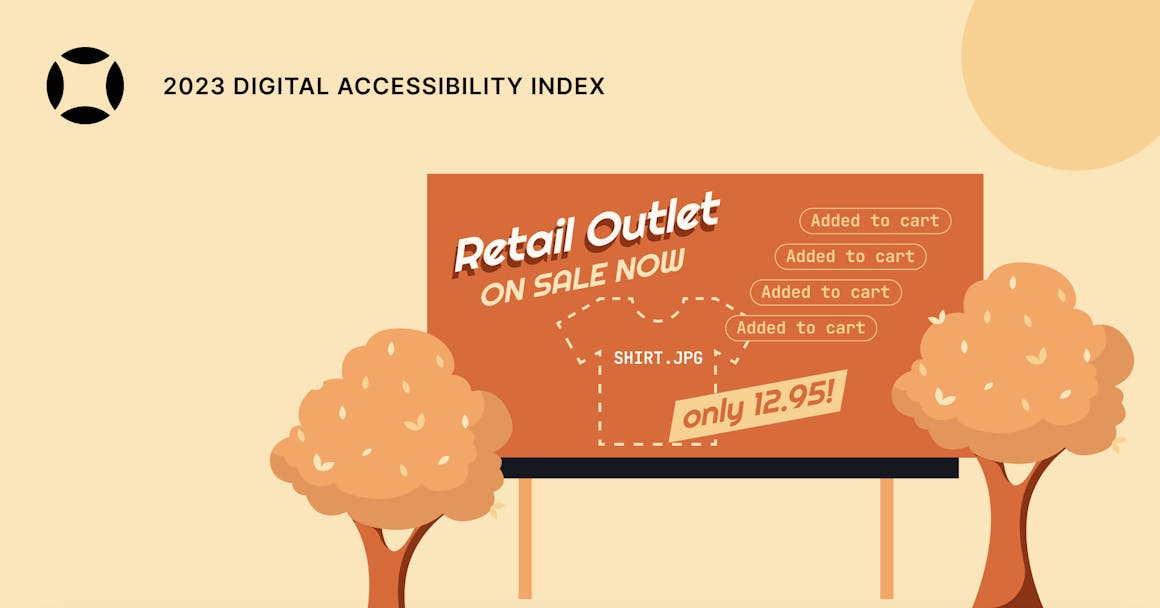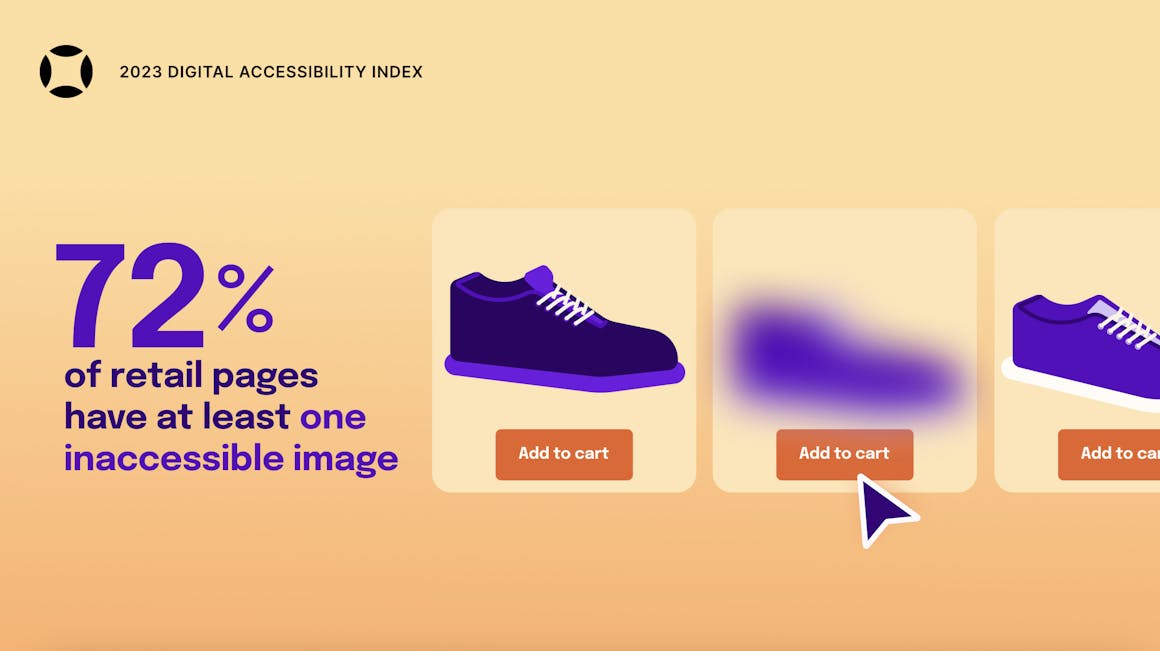Digital Accessibility Index: On Retail Sites
- 72% of retail pages have at least one inaccessible image
- Manual audits of the top retail sites uncovered significant accessibility barriers.
- Digital accessibility isn’t an edge case
- Methodology
See AudioEye in action
Watch Demo
Digital Accessibility Index: On Retail Sites, Accessibility Issues Are Driving Customers Away


Ready to see AudioEye in action?
Watch Demo
Breaking down key insights from AudioEye's 2023 Digital Accessibility Index.
Summary: We wanted to identify the biggest accessibility barriers that people with disabilities encounter when shopping online, so we scanned thousands of retail sites as part of our 2023 Digital Accessibility Index. Then we had our team of certified experts audit some of the world’s biggest retailers, focusing on essential site objectives like browsing products, adding items to their cart, or completing checkout. Here’s what we found.
E-commerce sales are on the rise again, after inflation and economic insecurity contributed to a slight decline in online shopping in 2022.
For people with disabilities, however, accessibility issues can make online shopping an unpleasant experience. Our scan of nearly 40,000 enterprise websites found that online retailers performed worse-than-average in key areas like image and form accessibility — and expert audits of the top retail sites revealed additional accessibility issues that prevented disabled shoppers from making purchases.
Here’s a breakdown of the most common accessibility issues on retail sites like Shopify and Squarespace today — plus insights from members of the disability community:
“It’s genuinely disheartening. And it’s way too common. I could not tell you how many times I’ve been unable to access my cart, fill out my shipping information, or solve the CAPTCHA.”
Chris Preiman | AudioEye A11iance Member
72% of retail pages have at least one inaccessible image — plus more insights.
Our scan of nearly 90,000 retail pages revealed a number of accessibility issues that can make it difficult for disabled shoppers to navigate between pages, compare products, or add items to their cart:
- 72% of retail pages had images with vague or missing image alternative text, one of the highest rates across all industries scanned.
- 68% of retail pages had at least one link that did not clearly state where it would take users, which can make it difficult for screen reader users to confidently navigate between pages.
- 47% of retail pages with a form had at least one unlabeled field, which can make it difficult for screen reader users to know what information to enter into each field.
For retailers everywhere, these numbers should be alarming. Studies have shown that 75% of online shoppers rely on product photos to help them make a decision. Image accessibility should be a top priority for retailers, yet it’s a consistent problem across most sites.

Manual audits of the top retail sites uncovered significant accessibility barriers.
Our expert review of the top retail sites confirmed many of the same issues as our automated scan — plus a number of additional barriers that can make it hard for disabled shoppers to navigate between pages or finish checking out.
For example: Our testers encountered a number of Add to Cart buttons that did not trigger any sort of audible announcement when clicked, which left non-sighted users unsure if an item was added to their cart — or if they accidentally added multiples of the same item.
On several occasions, our testers were unable to purchase something because the checkout form (which they had intentionally filled out wrong) did not audibly alert them to missing or incorrect information — or tell them what information to enter into each field.
When we asked members of the disability community about their own experiences shopping online, they acknowledged facing many of the same challenges — and expressed frustration at what can feel like slow responses from a number of the top retail sites.
“Accessibility issues have cost a number of companies some decent money because I have to shop elsewhere. And that makes me mad. And I get even madder when I have to get help finishing a purchase because I can’t go elsewhere. And now I actively resent giving them money.”
Chris Preiman | AudioEye A11iance Member
Digital accessibility isn’t an edge case … and disabled shoppers shouldn’t be ignored.
One of the biggest misconceptions about digital accessibility is that it’s some sort of edge case. In fact, people with disabilities are the largest minority in the United States.
In the United States, one in four adults lives with some type of disability. That number goes even higher when you include temporary disabilities, like broken limbs or short-term impairments following surgery or medical treatments.
According to the Global Economics of Disability 2020 report, people with disabilities control $13 trillion in disposable income, along with their friends and family.
“I’m not only loyal, but I will also tell all of my friends like “Hey, go here, it’s really easy, check this out.” because I’m excited. I love when I find something that’s super accessible.”
Marche Roberson | AudioEye A11iance Member
By prioritizing digital experiences that work for everyone, you can help narrow the accessibility gap and open your retail site’s digital doors to an audience that has been historically underserved.
Want to learn more about the accessibility of the world’s leading brands? Check out the full Digital Accessibility Index. Or, get a free scan of any URL on your website to see how you compare to the leading retailers.
Methodology
AudioEye conducted an automated scan of over 2 million pages across 40,000 websites from companies with over $100M in annual revenue, starting at the homepage and following every link until it scanned up to 100 pages per site. More than 3 billion site-specific elements were tested against 25 of the 78 WCAG 2.1 criteria. Following the scan, accessibility experts— including members of the disability community — audited the top sites in each industry, revealing which issues are most disruptive to users.
Ready to see AudioEye in action?
Watch Demo
Ready to test your website for accessibility?
Share post
Keep Reading

A Guide to Mobile App Accessibility
Mobile app accessibility is the practice of developing mobile apps that are accessible to individuals with disabilities. Learn how to create accessible apps.
accessibility
May 07, 2024

A Copywriter’s Guide to Accessibility
Elevate your copywriting with accessibility training designed to make your content more inclusive to audiences. Explore top accessibility courses for copywriters here.
accessibility
May 03, 2024

What Are Web Accessibility Specialist Certifications?
Thinking about earning a web accessibility certification? Here’s what you’ll need to know.
accessibility
May 02, 2024
